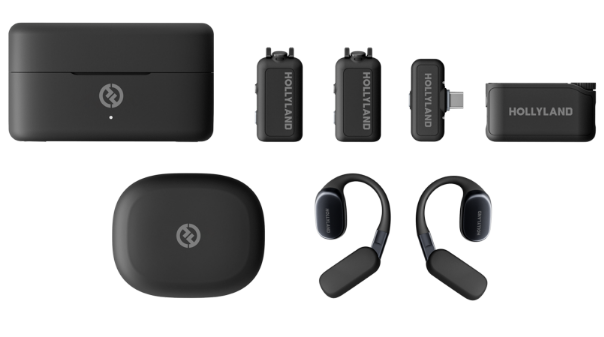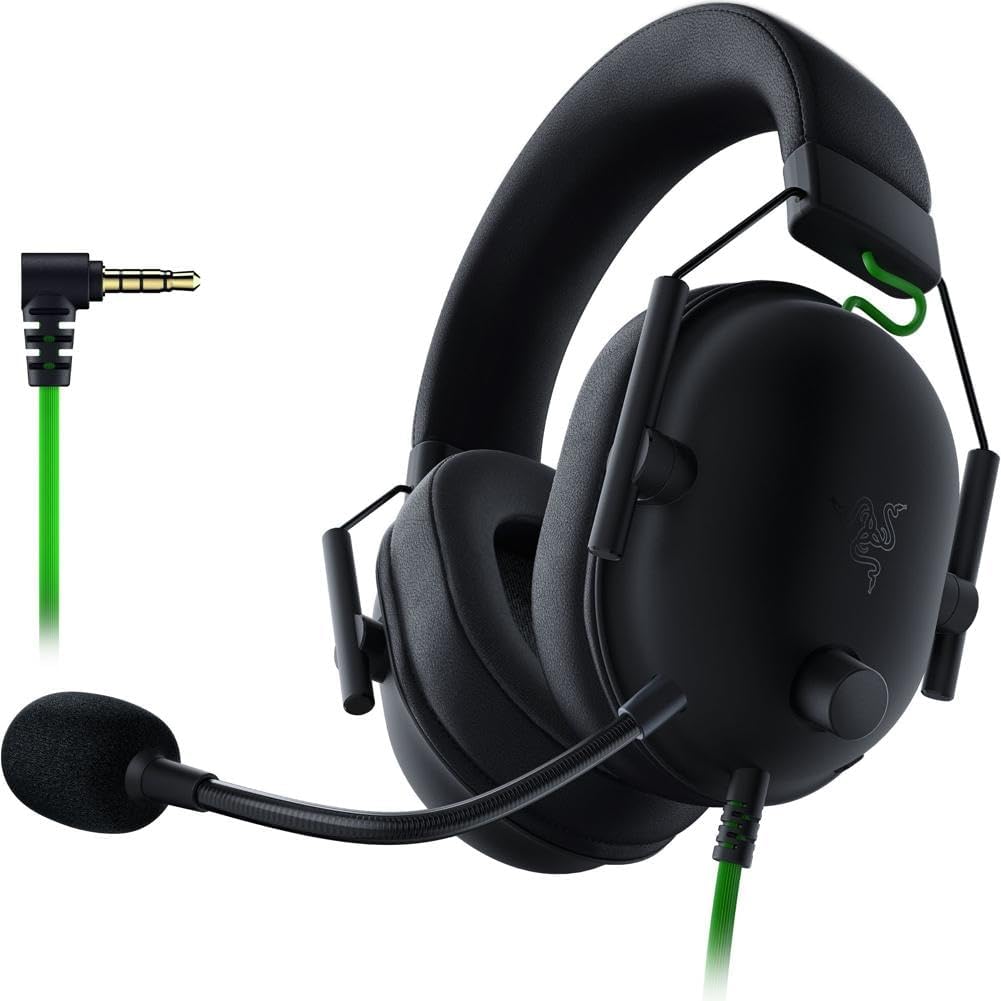When it comes to recording high-quality audio, background noise can be a real nuisance. Whether you’re recording a podcast, streaming on Twitch, or conducting a video conference call, unwanted noise can quickly ruin the listening experience for your audience. Fortunately, the solution is simple – a microphone with noise cancellation. In this article, we’ll take a closer look at some of the best microphones with noise cancellation on the market, so you can enjoy crystal-clear sound quality without any distractions.
Benefits of Using a Microphone with Noise Cancellation
Using a microphone with noise-cancellation technology can provide numerous benefits when recording audio. Firstly, it can help eliminate unwanted background noise, such as traffic, air conditioning, or even the sound of typing on a keyboard. This can significantly improve the clarity and quality of the recorded audio, making it easier for listeners to understand and follow.
In technical terms, noise cancellation technology uses a combination of hardware and software to analyze the incoming sound and create an inverse waveform that cancels out the unwanted noise. This is done in real-time, allowing the microphone to continuously adapt and adjust to changes in the environment. Some microphones even come with multiple levels of noise cancellation, allowing you to adjust the settings based on the amount of background noise present.
Overall, using a microphone with noise cancellation can make a significant difference in the quality of your recordings and improve the overall listening experience for your audience.
Factors to Observe when Buying a Microphone with Noise Cancellation
When choosing a microphone with noise cancellation, there are several factors to consider to ensure you get the best quality sound with minimum interference from background noise. Some of the key factors to consider include:
- Type of Noise Cancellation: There are two types of noise cancellation available in microphones – passive and active. Passive noise cancellation is achieved through the physical design of the microphone, such as using sound-absorbing materials to reduce background noise. Active noise cancellation uses electronic circuitry to cancel out background noise by generating an inverse sound wave. Active noise cancellation is generally more effective than passive noise cancellation.
- Directionality: Microphones can have different polar patterns that determine their sensitivity to sounds coming from different directions. Cardioid microphones, for example, are most sensitive to sounds coming from the front, while rejecting sounds from the sides and rear. Omnidirectional microphones, on the other hand, are equally sensitive to sounds from all directions. For noise cancellation purposes, a cardioid or supercardioid microphone is often recommended.
- Frequency Response: The frequency response of a microphone refers to the range of frequencies it can effectively capture. A microphone with a wider frequency response will capture more detail in the audio, but it may also capture more background noise. It’s important to choose a microphone with a frequency response that is appropriate for the type of recording you’ll be doing.
- Sensitivity: The sensitivity of a microphone refers to how effectively it can pick up sound. A microphone with higher sensitivity will capture more detail in the audio, but it may also be more prone to picking up background noise. It’s important to choose a microphone with an appropriate sensitivity level for your needs.
- Build Quality: The build quality of a microphone can also impact its noise cancellation capabilities. A well-built microphone will be less susceptible to picking up vibrations or handling noise, which can contribute to background noise.
Best Microphones with Noise Cancellation at a Glance
Hollyland Lark Max
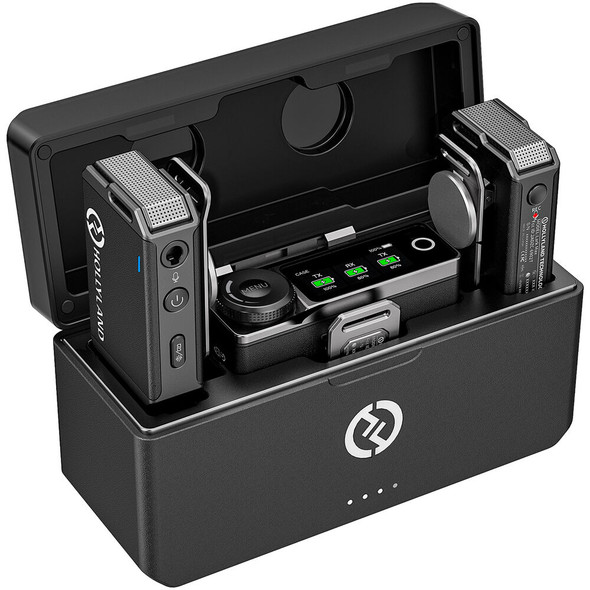
Price: $249.00
Product Page: https://www.hollyland.com/product/lark-max?internal_source=blog&internal_medium=2459
The Hollyland Lark Max is a significant upgrade from the previous models, such as the Lark M1. While inheriting several of its features, this wireless mic also comes with some serious transparent improvements. The kit comes with 1x receiver (RX) and 2x built-in omnidirectional microphones/transmitters (TX), allowing you to record two subjects simultaneously. The RX has a versatile clip to attach a belt or hot shoe mounts when used with a camera.
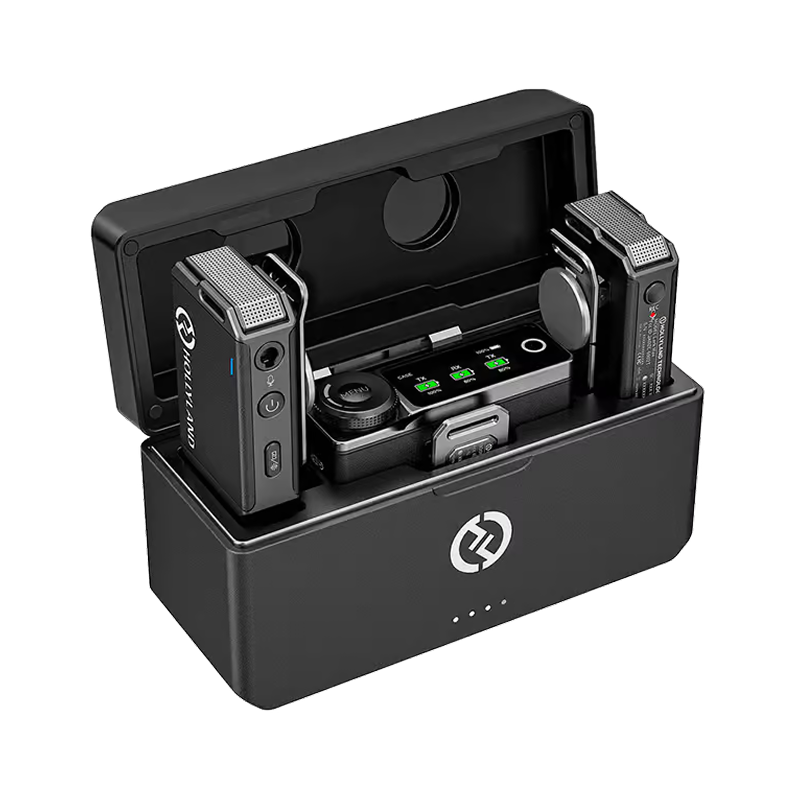
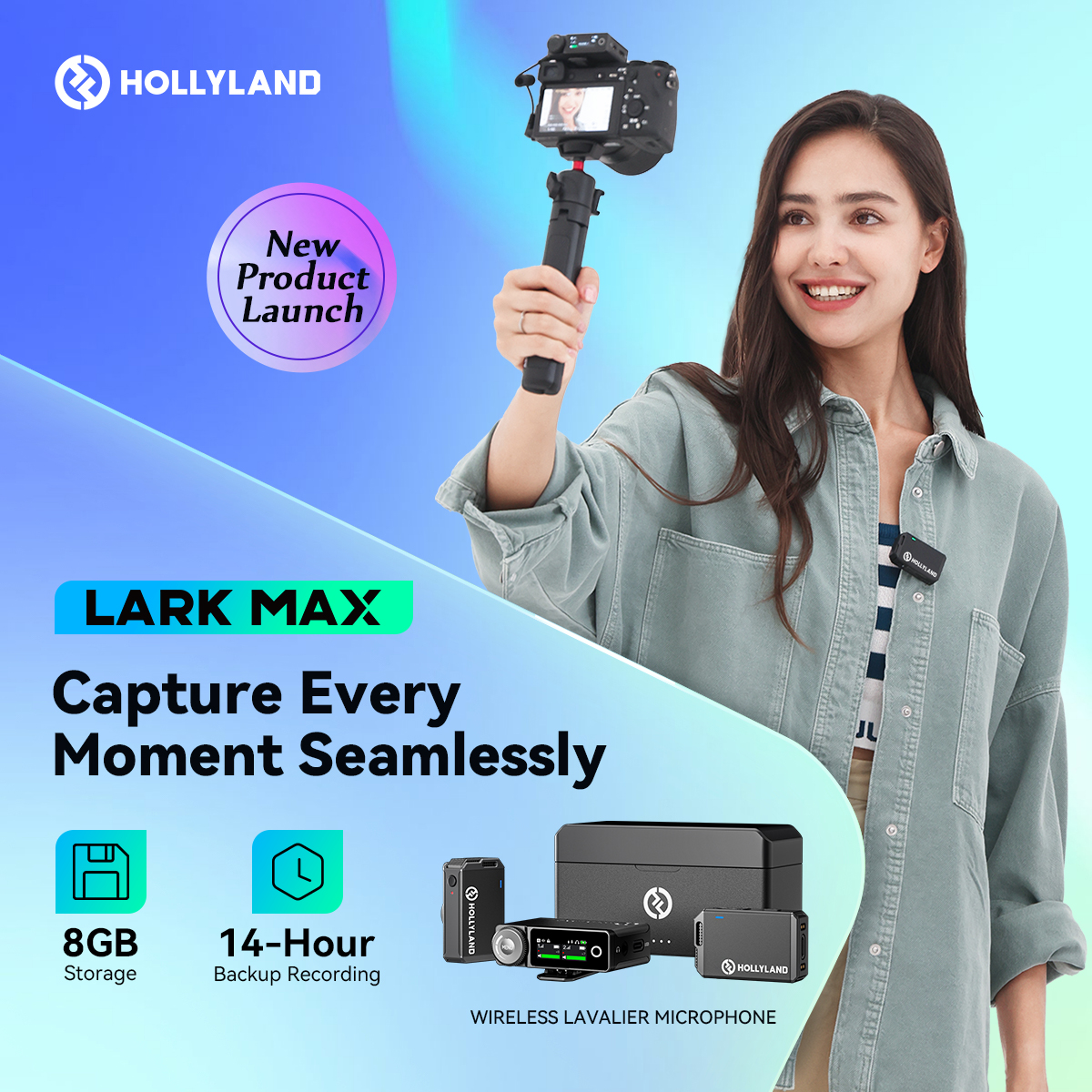
Hollyland LARK MAX - Professional Wireless Microphone
A professional wireless microphone system featuring studio-quality audio with advanced noise cancellation.
Key Features: Studio-Quality Audio | Magnetic Attachment | 8GB Internal Recording
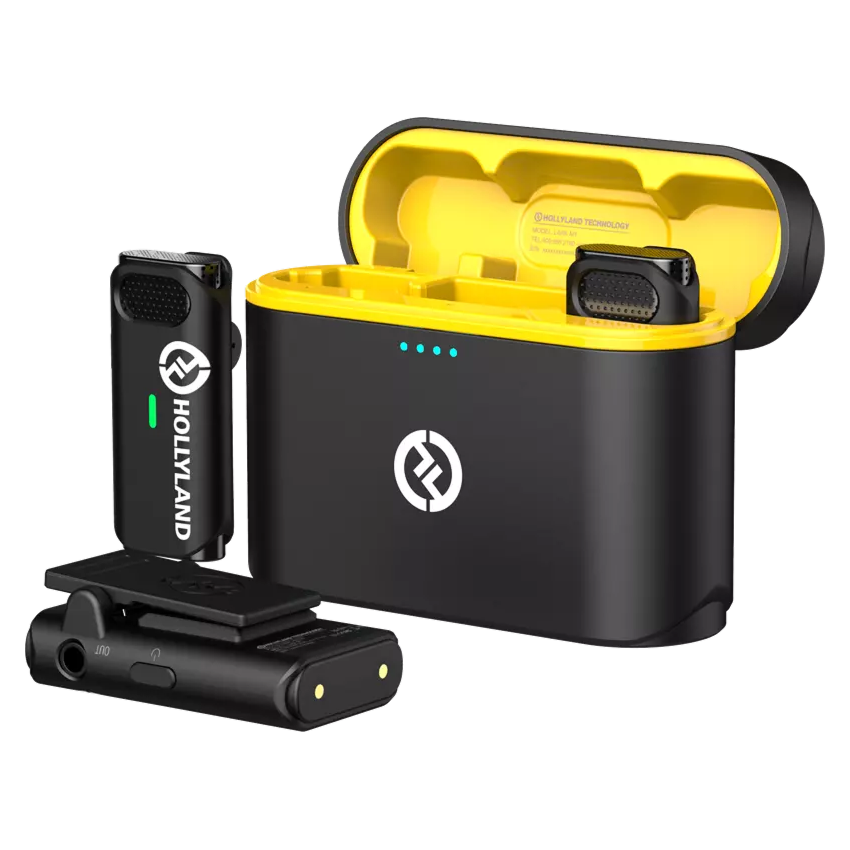
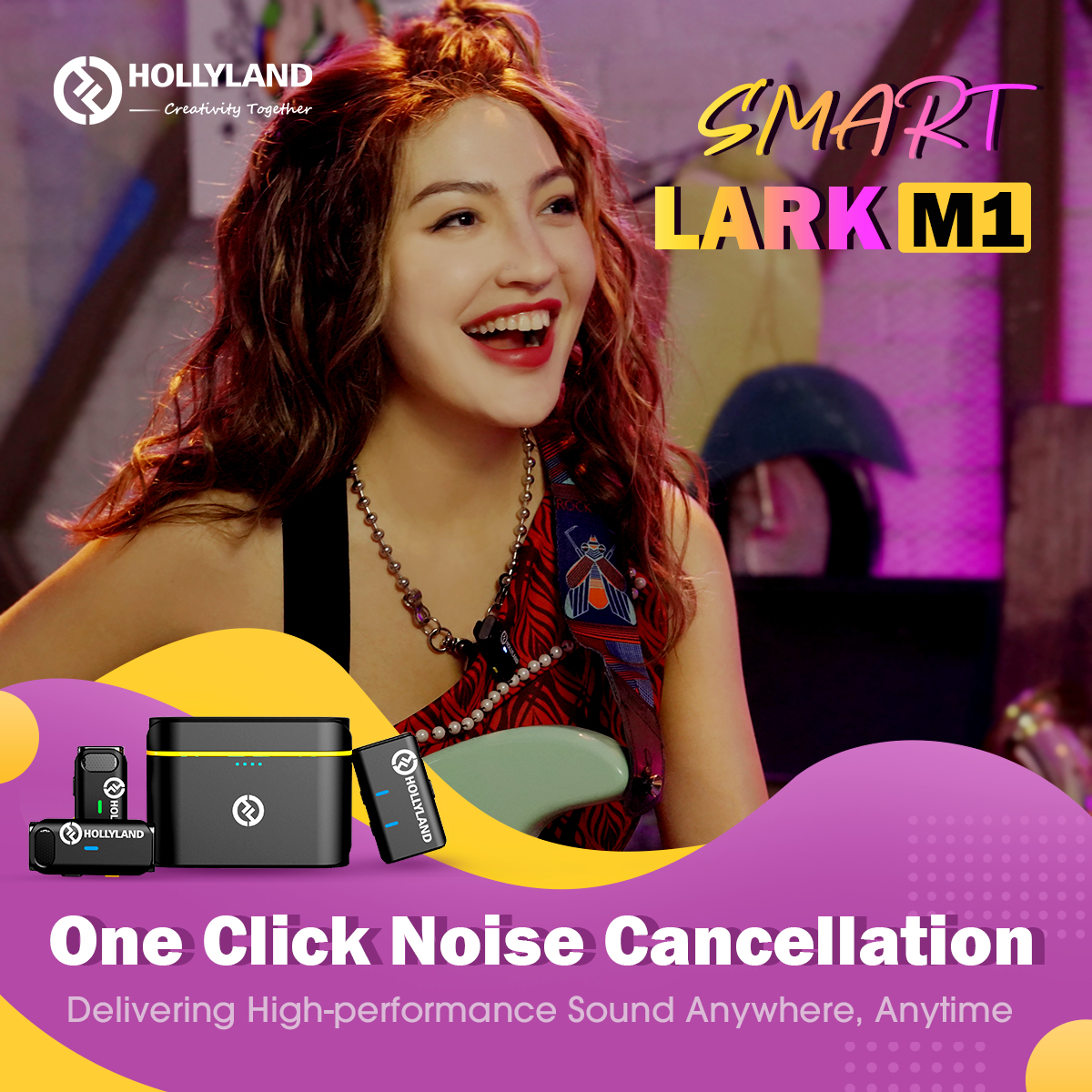
Hollyland LARK M1 - Tiny Wireless Microphone
A lightweight and user-friendly wireless microphone with one-click noise cancellation.
Key Features: Hi-Fi Sound Quality | Tiny & Light Design | Plug and Play
One of the most notable features of Hollyland Lark Max is the Environmental Noise Cancellation (ENC). It is a professional-grade technology that automatically identifies and reduces surrounding noises to ensure your audio remains clean and distortion-free even in some noisy environments.
Hollyland Lark Max, despite its size, provides enhanced control with the help of an LCD interface, permitting you to monitor different functions, including recording behavior, mute, noise cancellation, and more. This controllability is also found in the TX, allowing you to activate the noise reduction feature, mute the subject, and adjust recording levels directly from the unit.
Features
- Lark Max offers three recording modes – mono, stereo, and safety channel
- Each microphone can record audio up to 8GB without a receiver
- 2.4GHz wireless frequency operation
- 14 hours of recording time on internal storage
- 7.5 hours of battery time when paired
- Simple and quick auto-pairing
- Advanced Digital Processing (DSP) technology for improved audio signals
- 820ft of wireless transmission range
Pros
- This wireless microphone system permits for recording both interviewer and interviewee in high audio quality
- The controls and menu, including touch button and push dial, are very intuitive and non-technical
- The transmitters are not more than the size of a matchbox and are made with strong material
Cons
- This is not the smallest TX and RX kit on the market
Cyber Acoustics CVL-2230 Matterhorn USB Professional Recording Microphone
Price: $39.99
Product Page: https://www.cyberacoustics.com/cvl2230
The Cyber Acoustics CVL-2230 is a budget-friendly option for those who are looking for a microphone with noise cancellation. It is designed for use with laptops and desktop computers and can be used for a variety of applications, including video conferencing, gaming, and recording podcasts.

Features
- Noise-cancelling technology to eliminate background noise.
- Omnidirectional microphone picks up sound from all directions.
- 3.5mm jack for easy connection to a computer or laptop.
- Adjustable microphone boom allows for optimal positioning.
- Frequency response range of 20 Hz to 20kHz for clear and natural sound.
- Sample/bit rate: 48kHz/24-bit
- 7-foot cable length for flexibility in placement.
- Microphone mute switch for convenience.
- Compatible with Windows and Mac operating systems.
Pros
- Affordable price point.
- Effective noise cancellation technology.
- Omnidirectional microphone picks up sound from all directions.
- Adjustable microphone boom allows for optimal positioning.
- Simple plug-and-play setup with a 3.5mm jack.
Cons
- The microphone can be sensitive to touch and may pick up unwanted noise.
- The sound quality may not be as crisp and clear as higher-end models.
HyperX QuadCast USB Condenser Microphone
Price: $159.99
Product Page: https://hyperx.com/products/hyperx-quadcast-s-usb-microphone
The HyperX QuadCast is a stylish and high-performance USB microphone designed for gamers, podcasters, and streamers. It has a durable all-metal construction and comes with four selectable polar patterns, built-in shock mount, and an anti-vibration shock mount to reduce unwanted noise and vibrations.

Features
- Four polar patterns: stereo, omnidirectional, cardioid, bidirectional
- Frequency response: 20Hz-20kHz
- Sensitivity: -36dBV (1V/Pa at 1kHz)
- Sample/bit rate: 48kHz/16-bit
- Built-in pop filter
- Anti-vibration shock mount
- Tap-to-mute sensor with LED indicator
- Gain control and headphone output with volume control
Pros
- High-quality sound and versatile polar patterns
- Stylish and durable all-metal construction
- Built-in pop filter and anti-vibration shock mount help reduce unwanted noise
- Tap-to-mute sensor is convenient and easy to use
- Headphone output with volume control allows for real-time monitoring
Cons
- Higher price point compared to some other USB microphones
- Some users have reported occasional technical issues with the microphone’s software
Shure SM7B Vocal Dynamic Microphone
Price: $399
Product Page: https://www.shure.com/en-US/products/microphones/sm7b?variant=SM7B
The Shure SM7B is a dynamic microphone that has become a favourite among professionals for its excellent sound quality and versatility. It is ideal for podcasting, broadcasting, and recording music.
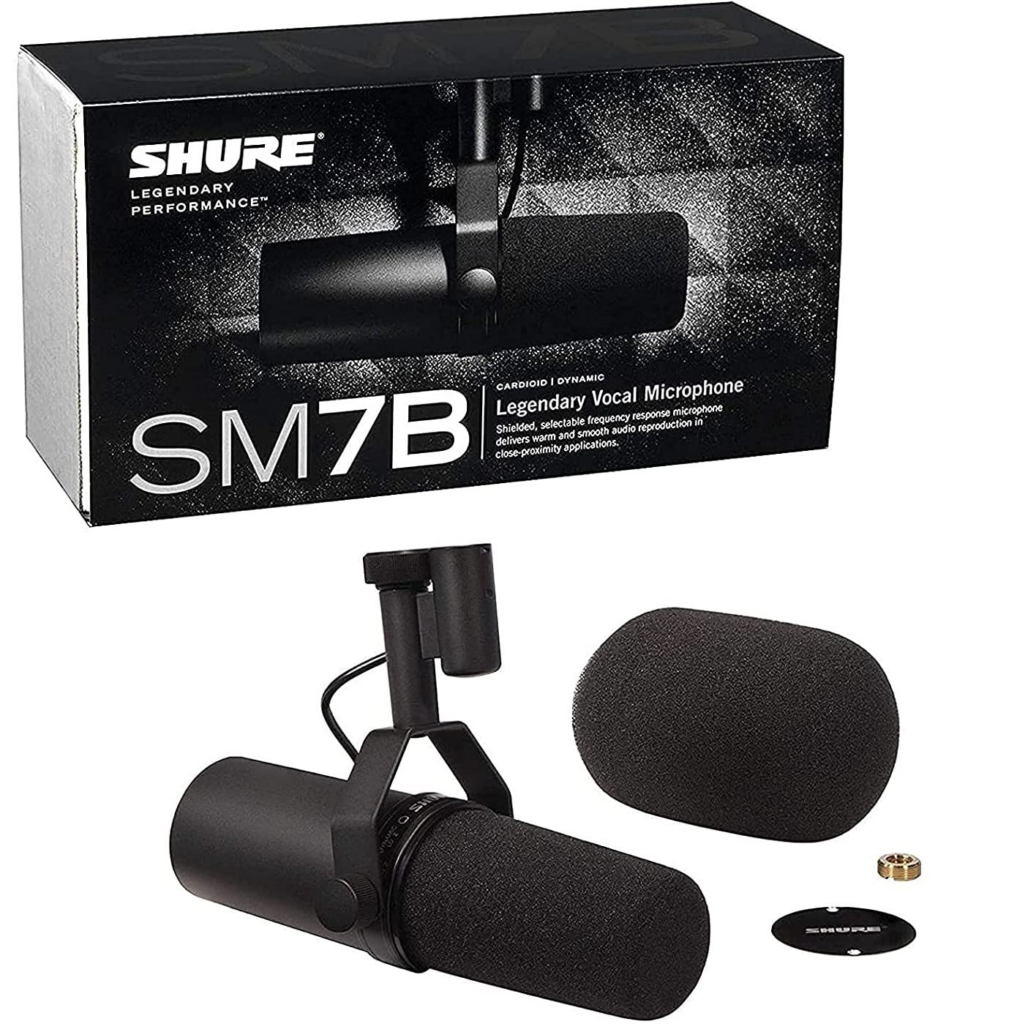
Features
- Dynamic microphone with a unidirectional polar pattern.
- Frequency response range of 50Hz to 20kHz.
- Bass roll-off and mid-range boost controls.
- Switchable bass cut and mid-range boost.
- High-pass filter and presence boost controls.
- Internal air suspension shock isolation.
- Cardioid polar pattern.
- Detachable windscreen.
Pros
- High-quality sound that is suitable for a wide range of applications.
- Excellent noise cancellation, making it ideal for noisy environments.
- Highly adjustable with a range of controls for customization.
- Durable build quality that can withstand years of use.
- Versatile mounting options, including a detachable windscreen.
Cons
- Requires a high-quality preamp or audio interface to achieve optimal performance.
Electro-Voice RE20 Broadcast Announcer Microphone
Price: $449
Product Page: https://products.electrovoice.com/na/es/re20
The Electro-Voice RE20 is a dynamic microphone with a long-standing reputation for quality and durability. This mic is highly regarded in the broadcasting and recording industry, and it is often used for capturing vocals, instruments, and sound effects. The RE20 is a versatile microphone with a unique design that reduces proximity effect, making it ideal for recording in tight spaces.

Features
- Large diaphragm dynamic microphone
- Cardioid polar pattern
- Frequency response range of 45Hz to 18kHz
- Bass roll-off switch
- Mid-range contour switch
- Internal pop filter
- Shock-mounted capsule to reduce handling noise
Pros
- Highly regarded for its clear and warm sound
- Unique design reduces proximity effect
- Built-in pop filter and shock mount help to reduce unwanted noise
- Durable construction for long-lasting use
Cons
- Higher price point compared to some other dynamic microphones
Neumann M149 Tube Dual-diaphragm Condenser Microphone
Price: $5495
Product Page: https://www.neumann.com/en-en/products/microphones/m-149-v-set/
The Neumann M149 is a high-end microphone that delivers exceptional sound quality and is suitable for a wide range of recording applications. This microphone is often used by professionals in music and broadcasting, as well as for voice-over work and podcasting. Its unique design and advanced features make it one of the best microphones for noise cancellation.

Features
- Large-diaphragm condenser microphone
- Pressure gradient transducer with double membrane capsule
- Cardioid polar pattern
- Frequency response range of 20Hz-20kHz
- Sensitivity of 34/47/62mV/Pa
- Maximum sound pressure level of 136dB SPL
- Switchable low-cut filter and pad
- Requires +48V phantom power
Pros
- Exceptional sound quality with clear and natural tones
- Versatile microphone suitable for a wide range of recording applications
- High sensitivity and maximum SPL make it ideal for loud sources
- Switchable low-cut filter and pad provide flexibility for different recording situations
- Effective noise cancellation and minimal self-noise
Cons
- Expensive compared to other microphones on the market
Comparison of the Best Microphones with Noise Cancellation
| Microphone Model | Noise Cancellation | Polar Pattern | Frequency Response | Sensitivity | Connector | Price |
| Hollyland Lark Max | Yes | Omnidirectional | 20Hz – 20kHz | -36dBFS | USB-C, TRS, TRRS, Lightning | Medium |
| Cyber Acoustics CVL-2230 | Yes | Cardioid | 20 Hz – 20 kHz | -47 dBV/Pa | USB | Low |
| HyperX QuadCast | Yes | Cardioid, Bidirectional, Omnidirectional, Stereo | 20 Hz – 20 kHz | -36 dBV/Pa | USB | Medium |
| Shure SM7B | Yes | Cardioid | 50 Hz – 20 kHz | -59 dBV/Pa | XLR | High |
| Electro-Voice RE 20 | Yes | Cardioid | 45 Hz – 18 kHz | 1.5 mV/Pa | XLR | High |
| Neumann M149 | Yes | Omnidirectional, Cardioid, Figure-8 | 20 Hz – 20 kHz | 34/47/62 mV/Pa | XLR | Very High |
Best Overall: The Lark Max by Hollyland wins the best overall recognition due to the abundance of features at a reasonable price. On the other hand, the Shure SM7B is a popular choice among professionals in the broadcasting and recording industries. With its cardioid polar pattern and low sensitivity, it effectively eliminates background noise while capturing clear and natural-sounding vocals. It also has a durable build and versatile mounting options.
Best Value: The best value option would be the Cyber Acoustics CVL-2230. It is a budget-friendly option that still provides decent noise cancellation and clear audio recordings. It has a cardioid polar pattern and a USB connector, making it easy to use with a computer or laptop. It is ideal for those who are just starting out with podcasting or voice recording.
Best Budget: For those on a tight budget, the best option would be the HyperX QuadCast. It has a mid-range price point but still provides high-quality noise cancellation and multiple polar patterns for versatility. It also has a sleek and stylish design that can fit well with any setup.
Conclusion
In conclusion, we’ve covered the topic of Best Microphones with Noise Cancellation in detail, discussing the benefits of using such microphones, factors to consider when choosing one, and reviewing six of the best options available in the market. All of the microphones we’ve reviewed feature noise cancellation technology, but they differ in terms of polar patterns, frequency response, sensitivity, and connectors.
We recommend the Hollyland Lark Max due to its professional-grade noise-canceling technology. Next, we suggest the HyperX QuadCast as the best overall option, with its versatile polar patterns, high-frequency response, and USB connector. The Shure SM7B is a close contender with its superior noise cancellation technology and cardioid polar pattern. For those on a budget, the Cyber Acoustics CVL-2230 is a great value option that provides decent noise cancellation capabilities.
In the end, the choice of microphone ultimately comes down to personal preference and specific needs. We encourage our readers to consider their own use case and budget when making a decision. If you have any questions or feedback, please feel free to leave them in the comments section below.
Frequently Asked Questions
What is a microphone with noise cancellation, and how does it work?
A microphone with noise cancellation is designed to reduce or eliminate unwanted background noise while recording audio. It works by using technology that analyses and filters out any sound that is not coming from the desired source, such as a person speaking directly into the microphone.
Can noise-canceling microphones eliminate all background noise?
No, while noise-canceling microphones can significantly reduce unwanted background noise, they cannot eliminate it entirely. Some microphones have better noise-cancellation capabilities than others, but there will always be some residual noise that remains.
What are the different types of polar patterns, and which one is best for noise cancellation?
There are three main types of polar patterns: cardioid, omnidirectional, and bidirectional. For noise cancellation, the cardioid pattern is generally the best choice, as it focuses on capturing sound from directly in front of the microphone and rejects sound from other directions.
Are USB microphones better than XLR microphones for noise cancellation?
It depends on the specific microphone and its noise-cancellation capabilities. Both USB and XLR microphones can have noise-cancellation features, but USB microphones tend to be more user-friendly and easier to set up, while XLR microphones may offer higher quality and more control over the sound.
Is the sensitivity of a microphone important for noise cancellation?
Yes, the sensitivity of a microphone can impact its ability to effectively cancel out background noise. A higher-sensitivity microphone may pick up more ambient noise, while a lower-sensitivity microphone may struggle to pick up softer sounds, including the speaker’s voice.
How important is frequency response for noise-canceling microphones?
Frequency response is important for all microphones, particularly for noise-canceling ones, as it determines the range of frequencies that the microphone can pick up. A wider frequency response range is generally better for noise cancellation, as it allows the microphone to capture more nuanced sounds and differentiate between background noise and the speaker’s voice.
Are all noise-cancelling microphones expensive?
No, there are many affordable options for noise-cancelling microphones on the market, including the Cyber Acoustics CVL-2230, which is a budget-friendly option that still offers good noise-cancellation capabilities.
Are there any downsides to using a noise-cancelling microphone?
One potential downside of using a noise-cancelling microphone is that it may remove some of the ambient noise that adds depth and atmosphere to an audio recording, making it sound overly sterile or artificial. Additionally, some microphones may struggle to cancel out certain types of background noise, such as high-pitched sounds or sudden, sharp noises.
Can I use a noise-cancelling microphone for gaming or streaming?
Yes, noise-cancelling microphones are often used for gaming and streaming, as they can help to eliminate unwanted background noise, such as keyboard clicks or other ambient sounds, and improve the overall audio quality of the stream or recording.
Can I use a noise-cancelling microphone for podcasting or recording music?
Yes, noise-cancelling microphones are often used for podcasting and music recording, as they can help to ensure clear, high-quality audio recordings without interference from unwanted background noise.
What is the best way to clean a noise-cancelling microphone?
The best way to clean a noise-cancelling microphone is to use a soft cloth or microfiber towel to gently wipe away any dirt or debris that may have accumulated on the microphone’s surface. Avoid using harsh chemicals or abrasive materials that could damage.

































.png)


